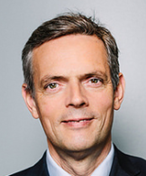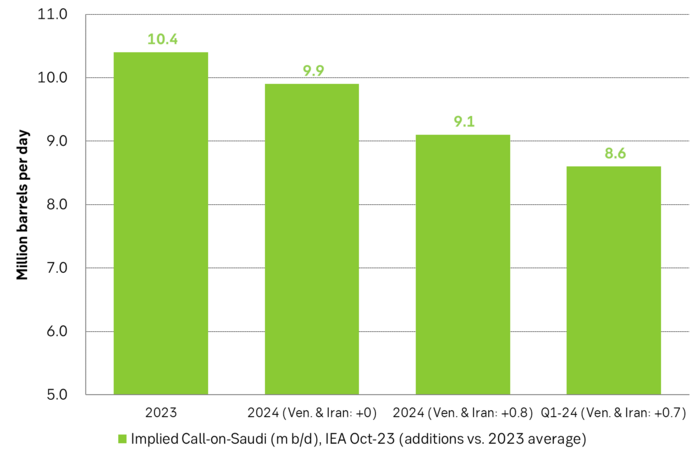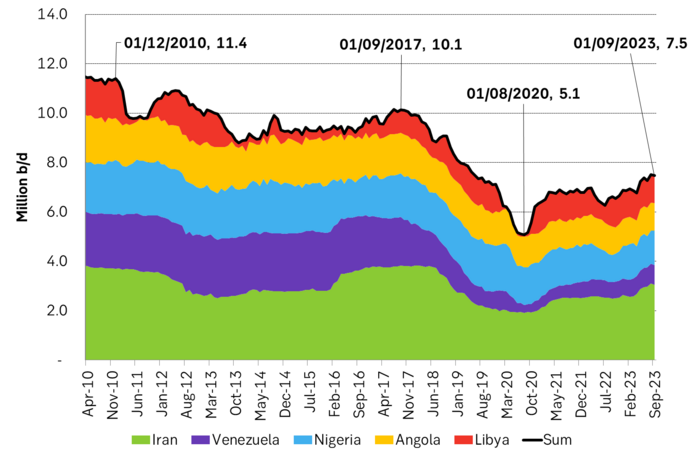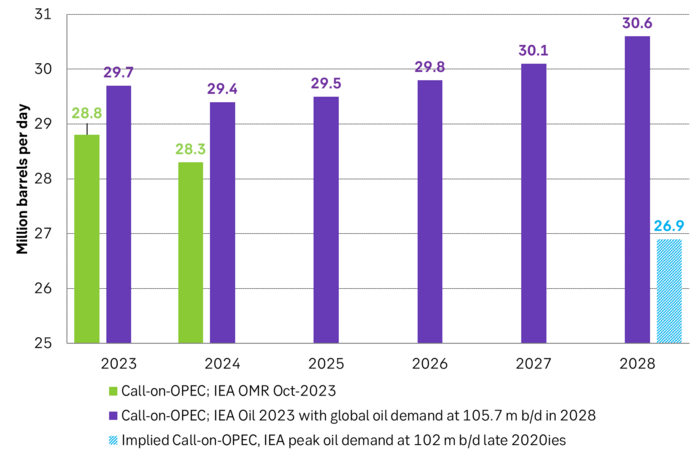Analys
More from Venezuela and Iran means smaller pie for Saudi

Production in Venezuela and Iran is on the rise and is set to rise further in the coming months and in 2024. Combined their production could grow by 0.8 m b/d YoY to 2024 (average year to average year). The IEA projected in its latest OMR (Oct-2023) that call-on-OPEC will fall to 28.3 m b/d in 2024, a decline of 0.5 m b/d. This combination would drive implied call-on-Saudi from 10.4 m b/d in 2023 to only 9.1 m b/d in 2024 and as low as 8.6 m b/d in Q1-24 if Saudi Arabia has to do all the heavy lifting alone. Wider core OPEC cooperation may be required.

The IEA is out in the news today projecting peak oil demand this decade with global demand standing at no more than 102 m b/d towards the end of this decade. If so it would imply a call-on-Non-OPEC of only 66.4 m b/d in 2028 assuming that OPEC in general will demand a market share of 30 m b/d + NGL of 5.6 m b/d. The IEA (Oct-23) projects non-OPEC production to average 68.8 m b/d in 2024. That’s already 2.4 m b/d more than what would be sustainable over time if global oil demand is set to peak later this decade. Oil producers in general cannot have a production growth strategy in a peak oil demand world.
The US has decided to lift sanctions towards Venezuela for six months (18 April) as a measure to tempt it to move towards more democratic processes. And if it does, then the lifting of sanctions could continue after the 6 months. A primary opposition election took place this weekend with lawmaker Maria Corina Machado currently holding 93% of the vote count. Venezuela will next year hold a presidential election but fair play seems unlikely with Maduro in charge. The lifting of sanctions allows Venezuela’s PdV to resume exports to all destinations. Bans on new, foreign investments in the oil and gas sector are also lifted though Russian entities and JV’s are still barred.
Venezuela produced 0.8 m b/d in September and indicates that it can lift production by 0.2 m b/d by year and with more rigs and wells by 0.5 m b/d to 1.3 m b/d in the medium term.
Oil production in Iran has been on a steady rise since its low-point of 2.0 m b/d in 2020. Last year it produced 2.5 m b/d. In September it produced 3.1 m b/d, but Iran’s oil minister says production now is at 3.3 m b/d. Iran’s rising production and exports is not about the US being more lenient in its enforcement of sanctions towards Iran. It is more about Iran finding better ways to circumvent them but even more importantly that China is importing more and more oil from Iran.
Production by Iran and Venezuela is recovering. YoY production from the two could rise by close to 0.8 m b/d in 2024. This will lead to a decline in call-on-Saudi oil.

The IEA estimated in its latest OMR report that call-on-OPEC will fall from 28.8 m b/d in 2023 to 28.3 m b/d in 2024. If all OPEC members except Saudi Arabia produces the same amount in 2024 as in 2023, then the need for Saudi Arabia’s oil (call-on-Saudi) will fall from a healthy 10.4 m b/d in 2023 to a still acceptable 9.9 m b/d in 2024. Its normal production is roughly 10 m b/d.
If however production by Iran and Venezuela rise by a combined 0.5 m b/d YoY in 2024, then call-on-Saudi will fall to 9.4 m b/d which is not so good but still manageable. But if Iran’s oil minister is correct when he says that its current production now is at 3.3 m b/d, then it is not far fetched to assume that Iran’s oil production may average maybe 3.4-3.5 m b/d in 2024. That would yield a YoY rise of 0.6 m b/d just for Iran. If we also assume that Venezuela manages to lift its production from 0.8 m b/d this year to 1.0 m b/d in 2024, then the combined growth from the two is closer to 0.8 m b/d. That would push call-on-Saudi down to only 9.1 m b/d which is not good at all. It would require Saudi Arabia to produce at its current production of 9.0 m b/d all through 2024.
The IEA further estimates that call-on-OPEC will average 27.7 m b/d in Q1-24. If we assume Iran @ 3.4 m b/d and Venezuela @ 1.0 m b/d then call-on-Saudi in Q1-24 will only be 8.6 m b/d. I.e. Saudi Arabia will have to cut production further to 8.6 m b/d in Q1-24. At that point Saudi Arabia will likely need or like other core OPEC members like Iraq, Kuwait and UAE as well as Russia to join in.
Implied call-on-Saudi. Call-on-OPEC is set to decline from 28.8 m b/d to 28.3 m b/d to 2024. If all OPEC members produced the same in 2024 as in 2023 then call-on-Saudi would fall by 0.5 m b/d to 9.9 m b/d. But if Venezuela and Iran increases their combined production by 0.8 m b/d YoY in 2024 then call-on-Saudi falls to 9.1 m b/d.

If we look a little broader on this topic and also include Libya, Nigeria and Angola we see that this group of OPEC members produced 11.4 m b/d in 2010, 10.1 m b/d in 2017 and only 5.1 m b/d at the low-point in August 2020. The decline by these OPEC members has of course the other OPEC and OPEC+ members to stem the rising flood of US shale oil production. The production from this unfortunate group of OPEC-laggards is however now on the rise reaching 7.5 m b/d in September. With more from Iran and Venezuela it could rise to 8.0 m b/d in 2024. Production from Nigeria and Angola though still looks to be in gradual decline while Libya looks more sideways. So for the time being it is all about the revival of Iran and Venezuela.
The unfortunate OPEC-laggards had a production of 11.4 m b/d in 2010. But production then fell to only 5.1 m b/d in August 2020. It helped the rest of OPEC’s members to manage the huge increase in US shale oil production. Production from these countries are now on the rebound. Though Nigeria and Angola still seems to be in gradual decline.

What everyone needs to be attentive to is that call-on-OPEC and even more importantly call-on-Saudi can only erode to a limit before Saudi/OPEC/Russia will have to take action. Especially if the forecast for needed oil from OPEC/Saudi for the nearest 2-3 years is in significant decline. Then they will have to take action in the sense that they stop defending the price and allows the price to fall sharply along with higher production. And yet again it is US shale oil producers who will have to take the brunt of the pain. They are the only oil producers in the world who can naturally and significantly reduce their production rather quickly. I.e. the US shale oil players will have to be punished into obedience, if possible, yet one more time.
We don’t think that it is any immediate risk for this to happen as US shale oil activity is slowing while global oil demand has rebounded following Covid-lockdowns. But one needs to keep a watch on projections for call-on-OPEC and call-on-Saudi stretching 1-2-3 years forward on a continuous basis.
In its medium term oil market outlook, Oil2023, the IEA projected a fairly healthy development for call-on-OPEC to 2028. First bottoming out at 29.4 m b/d in 2024 before rising gradually to 30.6 m b/d in 2028. The basis for this was a slowing though steady rise in global oil demand to 105.7 m b/d in 2028 together with stagnant non-OPEC production due to muted capex spending over the past decade. But this projection has already been significantly dented and reduced in IEA’s latest OMR from October where call-on-OPEC for 2024 is projected at only 28.3 m b/d.
In a statement today the IEA projects that global oil demand will peak this decade and consume no more than 102 m b/d in the late 2020ies due to (in large part) rapid growth in EV sales. This would imply a call-on-OPEC of only 26.9 m b/d in 2028. It is not a viable path for OPEC to produce only 26.9 m b/d in 2028. Especially if production by Iran and Venezuela is set to revive. I.e. OPEC’s pie is shrinking while at the same time Iran and Venezuela is producing more. In this outlook something will have to give and it is not OPEC.
One should here turn this on its head and assume that OPEC will produce 30 m b/d in 2028. Add OPEC NGLs of 5.6 m b/d and we get 35.6 m b/d. If global oil demand in 2028 stands at only 102 m b/d then call-on-Non-OPEC equates to 66.4 m b/d. That is 3.1 m b/d less than IEA’s non-OPEC production projection for 2028 of 69.5 m b/d but also higher than non-OPEC production projection of 68.8 m b/d (IEA, Oct-23) is already 2.4 m b/d too high versus what is a sustainable level.
What this of course naturally means is that oil producers in general cannot have production growth as a strategy in a peak-oil-demand-world with non-OPEC in 2024 already at 2.4 m b/d above its sustainable level.
The US is set to growth its hydrocarbon liquids by 0.5 m b/d YoY in 2024. But in a zero oil demand growth world that is way, way too much.

Analys
Tightening fundamentals – bullish inventories from DOE

The latest weekly report from the US DOE showed a substantial drawdown across key petroleum categories, adding more upside potential to the fundamental picture.

Commercial crude inventories (excl. SPR) fell by 5.8 million barrels, bringing total inventories down to 415.1 million barrels. Now sitting 11% below the five-year seasonal norm and placed in the lowest 2015-2022 range (see picture below).
Product inventories also tightened further last week. Gasoline inventories declined by 2.1 million barrels, with reductions seen in both finished gasoline and blending components. Current gasoline levels are about 3% below the five-year average for this time of year.
Among products, the most notable move came in diesel, where inventories dropped by almost 4.1 million barrels, deepening the deficit to around 20% below seasonal norms – continuing to underscore the persistent supply tightness in diesel markets.
The only area of inventory growth was in propane/propylene, which posted a significant 5.1-million-barrel build and now stands 9% above the five-year average.
Total commercial petroleum inventories (crude plus refined products) declined by 4.2 million barrels on the week, reinforcing the overall tightening of US crude and products.


Analys
Bombs to ”ceasefire” in hours – Brent below $70

A classic case of “buy the rumor, sell the news” played out in oil markets, as Brent crude has dropped sharply – down nearly USD 10 per barrel since yesterday evening – following Iran’s retaliatory strike on a U.S. air base in Qatar. The immediate reaction was: “That was it?” The strike followed a carefully calibrated, non-escalatory playbook, avoiding direct threats to energy infrastructure or disruption of shipping through the Strait of Hormuz – thus calming worst-case fears.

After Monday morning’s sharp spike to USD 81.4 per barrel, triggered by the U.S. bombing of Iranian nuclear facilities, oil prices drifted sideways in anticipation of a potential Iranian response. That response came with advance warning and caused limited physical damage. Early this morning, both the U.S. President and Iranian state media announced a ceasefire, effectively placing a lid on the immediate conflict risk – at least for now.
As a result, Brent crude has now fallen by a total of USD 12 from Monday’s peak, currently trading around USD 69 per barrel.
Looking beyond geopolitics, the market will now shift its focus to the upcoming OPEC+ meeting in early July. Saudi Arabia’s decision to increase output earlier this year – despite falling prices – has drawn renewed attention considering recent developments. Some suggest this was a response to U.S. pressure to offset potential Iranian supply losses.
However, consensus is that the move was driven more by internal OPEC+ dynamics. After years of curbing production to support prices, Riyadh had grown frustrated with quota-busting by several members (notably Kazakhstan). With Saudi Arabia cutting up to 2 million barrels per day – roughly 2% of global supply – returns were diminishing, and the risk of losing market share was rising. The production increase is widely seen as an effort to reassert leadership and restore discipline within the group.
That said, the FT recently stated that, the Saudis remain wary of past missteps. In 2018, Riyadh ramped up output at Trump’s request ahead of Iran sanctions, only to see prices collapse when the U.S. granted broad waivers – triggering oversupply. Officials have reportedly made it clear they don’t intend to repeat that mistake.
The recent visit by President Trump to Saudi Arabia, which included agreements on AI, defense, and nuclear cooperation, suggests a broader strategic alignment. This has fueled speculation about a quiet “pump-for-politics” deal behind recent production moves.
Looking ahead, oil prices have now retraced the entire rally sparked by the June 13 Israel–Iran escalation. This retreat provides more political and policy space for both the U.S. and Saudi Arabia. Specifically, it makes it easier for Riyadh to scale back its three recent production hikes of 411,000 barrels each, potentially returning to more moderate increases of 137,000 barrels for August and September.
In short: with no major loss of Iranian supply to the market, OPEC+ – led by Saudi Arabia – no longer needs to compensate for a disruption that hasn’t materialized, especially not to please the U.S. at the cost of its own market strategy. As the Saudis themselves have signaled, they are unlikely to repeat previous mistakes.
Conclusion: With Brent now in the high USD 60s, buying oil looks fundamentally justified. The geopolitical premium has deflated, but tensions between Israel and Iran remain unresolved – and the risk of missteps and renewed escalation still lingers. In fact, even this morning, reports have emerged of renewed missile fire despite the declared “truce.” The path forward may be calmer – but it is far from stable.
Analys
A muted price reaction. Market looks relaxed, but it is still on edge waiting for what Iran will do

Brent crossed the 80-line this morning but quickly fell back assigning limited probability for Iran choosing to close the Strait of Hormuz. Brent traded in a range of USD 70.56 – 79.04/b last week as the market fluctuated between ”Iran wants a deal” and ”US is about to attack Iran”. At the end of the week though, Donald Trump managed to convince markets (and probably also Iran) that he would make a decision within two weeks. I.e. no imminent attack. Previously when when he has talked about ”making a decision within two weeks” he has often ended up doing nothing in the end. The oil market relaxed as a result and the week ended at USD 77.01/b which is just USD 6/b above the year to date average of USD 71/b.

Brent jumped to USD 81.4/b this morning, the highest since mid-January, but then quickly fell back to a current price of USD 78.2/b which is only up 1.5% versus the close on Friday. As such the market is pricing a fairly low probability that Iran will actually close the Strait of Hormuz. Probably because it will hurt Iranian oil exports as well as the global oil market.
It was however all smoke and mirrors. Deception. The US attacked Iran on Saturday. The attack involved 125 warplanes, submarines and surface warships and 14 bunker buster bombs were dropped on Iranian nuclear sites including Fordow, Natanz and Isfahan. In response the Iranian Parliament voted in support of closing the Strait of Hormuz where some 17 mb of crude and products is transported to the global market every day plus significant volumes of LNG. This is however merely an advise to the Supreme leader Ayatollah Ali Khamenei and the Supreme National Security Council which sits with the final and actual decision.
No supply of oil is lost yet. It is about the risk of Iran closing the Strait of Hormuz or not. So far not a single drop of oil supply has been lost to the global market. The price at the moment is all about the assessed risk of loss of supply. Will Iran choose to choke of the Strait of Hormuz or not? That is the big question. It would be painful for US consumers, for Donald Trump’s voter base, for the global economy but also for Iran and its population which relies on oil exports and income from selling oil out of that Strait as well. As such it is not a no-brainer choice for Iran to close the Strait for oil exports. And looking at the il price this morning it is clear that the oil market doesn’t assign a very high probability of it happening. It is however probably well within the capability of Iran to close the Strait off with rockets, mines, air-drones and possibly sea-drones. Just look at how Ukraine has been able to control and damage the Russian Black Sea fleet.
What to do about the highly enriched uranium which has gone missing? While the US and Israel can celebrate their destruction of Iranian nuclear facilities they are also scratching their heads over what to do with the lost Iranian nuclear material. Iran had 408 kg of highly enriched uranium (IAEA). Almost weapons grade. Enough for some 10 nuclear warheads. It seems to have been transported out of Fordow before the attack this weekend.
The market is still on edge. USD 80-something/b seems sensible while we wait. The oil market reaction to this weekend’s events is very muted so far. The market is still on edge awaiting what Iran will do. Because Iran will do something. But what and when? An oil price of 80-something seems like a sensible level until something do happen.
-

 Nyheter4 veckor sedan
Nyheter4 veckor sedanStor uppsida i Lappland Guldprospekterings aktie enligt analys
-

 Nyheter4 veckor sedan
Nyheter4 veckor sedanSilverpriset släpar efter guldets utveckling, har mer uppsida
-

 Nyheter3 veckor sedan
Nyheter3 veckor sedanUppgången i oljepriset planade ut under helgen
-

 Nyheter3 veckor sedan
Nyheter3 veckor sedanLåga elpriser i sommar – men mellersta Sverige får en ökning
-

 Nyheter2 veckor sedan
Nyheter2 veckor sedanMahvie Minerals växlar spår – satsar fullt ut på guld
-

 Analys3 veckor sedan
Analys3 veckor sedanVery relaxed at USD 75/b. Risk barometer will likely fluctuate to higher levels with Brent into the 80ies or higher coming 2-3 weeks
-

 Nyheter1 vecka sedan
Nyheter1 vecka sedanOljan, guldet och marknadens oroande tystnad
-

 Nyheter1 vecka sedan
Nyheter1 vecka sedanJonas Lindvall är tillbaka med ett nytt oljebolag, Perthro, som ska börsnoteras








